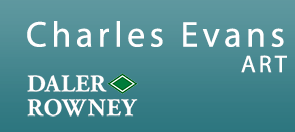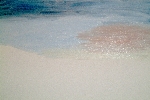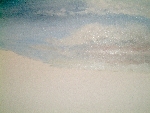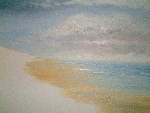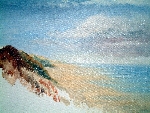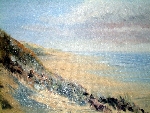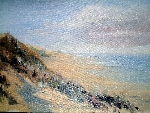Druridge Bay Oil
| STAGE BY STAGE | |||||
|
|||||
|
As you can see from the first image, I've done a very quick outline of the sand dunes and sea line in pencil. This may be slightly unorthodox to do pencil on canvas, but then again, I am unconventional and break the rules all the time. After all, who made the rules and as long as the result is right that's all I care about. |
|||||
|
The sky wash was applied using my No.18 Georgian short flat wash brush. The main blue colour is cobalt blue, the darker blue cobalt blue with a touch of Payne's grey. The warmer colour is violet with a touch of sepia mixed in. The yellow in the bottom right is Naples yellow. And what a mess it looks. After a couple of minutes after all this paint is applied, I used my cloth and scrubbed it all together. Now using my No.12 Georgian filbert, I added my white for the cloud areas and softened the edges again using my cloth. |
|
||||
|
|
For the sea, I used my cobalt blue with a touch of white making sure that it is mixed well on the palette so as not to get any lumpy bits, and I used my No.12 filbert and quickly stroked it in making sure it gets slightly weaker the further away it goes. Once the whole area is blocked in, I stroked some of it up into the beach and added a tiny touch of Payne's grey to the blue to darken it and a few strokes of this were added as an odd wave here and there. Now with my cloth I softened the distance line of the sea into the sky. Now to my No.3 Dalon rigger, and using titanium white added a few waves here and there (just a few squiggly bits). In the next image you will see that my beach is added and for this I used raw sienna with a touch of Naples yellow and my No.12 filbert and very quickly just stroked this across the beach lightening slightly in the far distance. |
||||
|
Now for the sand dunes. I started off with light mixtures of Naples yellow and raw sienna for the far sand dunes. Darkening slightly with a touch of Hooker's green and Naples yellow mixed, this mixture gets slightly stronger the nearer I come forward. Into the foreground sand dunes, using my No.12 filbert and No.10 long flat, I built up the dark areas with quick rough strokes using mixtures of raw sienna, Naples yellow, Payne's grey, Hooker's green, here and there, my violet (as in the sky) and sepia. These were all bashed on very quickly, followed by a little scrubbing here and there by the cloth. |
|
||||
| In the final images you will see that I have added shadow into the sand dune areas getting weaker as it goes further away. For this I used Payne's grey with a touch of cobalt blue and again the violet. Also I added some of this mixture using my No.12 filbert into the beach, just a few daubs here and there. | |||||
| For the people these are just very quick strokes with my rigger brush, a little bit of titanium white and a little bit of the violet, a touch of Payne's grey to highlight the dark side here and there, notice I drag these down into the beach as well to give the feeling of reflection on a wet beach. The canvas is Daler-Rowney stretch canvas and it is a very big one (90cm x 60cm). All the mixes of paints were mixed down with low odour thinners and painting medium, for these I just have dippers clipped onto my palette and literally dip and go. And there we go, another oil bites the dust. I must admit I am really secretly quite pleased with how they are going. Especially this one as it's home, because the beach is only 1 ¼ miles from my house, and looking at the painting I get the feel of my beach. |
|
||||
